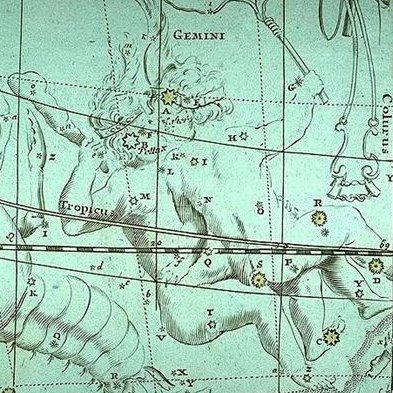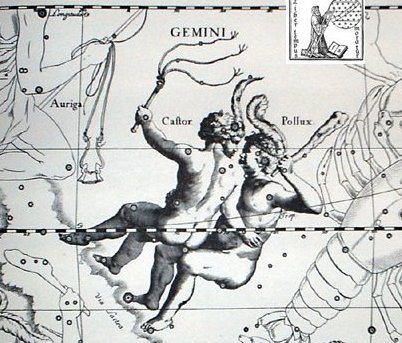Next page:
The
last star of the 4th
Arab manzil Al
Han'ah was
Alzirr (ξ),
often depicted at
the right foot of
Pollux, although the
more enlightened
Hevelius has Alzirr
at his left foot:
.

In
rongorongo times
heliacal Alzirr (the
Button) coincided
with July 4 (185) at
the opposite side of
Nunki heralding the
beginning of 'the
Sea'. Therefore a
new 'Land' (Mother
Earth) began at 7h
and 12 hours later
the 'Lord of the
Lake' returned.
... 'The earth rises
up from the sea
again, and is green
and beautiful and
things grow without
sowing. Vidar and
Vali are alive, for
neither the sea nor
the flames of Surt
have hurt them and
they dwell on the
Eddyfield, where
once stood Asgard.
There come also the
sons of Thor, Modi
and Magni, and bring
along his
hammer. There come
also Balder and
Hoder from the other
world. All sit down
and converse
together. They
rehearse their runes
and talk of events
of old days. Then
they find in the
grass the golden
tablets that the
Aesir once played
with.
Two children of men
will also be found
safe from the great
flames of Surt.
Their names, Lif and
Lifthrasir, and they
feed on the morning
dew and from this
human pair will come
a great population
which will fill the
earth. And strange
to say, the sun,
before being
devoured by Fenrir,
will have borne a
daughter, no less
beautiful and going
the same ways as her
mother.'
In
the time of
Gregorius XIII
heliacal Alzirr was
at the end of June
and heliacal Nunki
was in day 364:
 |
 |
 |
 |
|
Ga2-9 |
Ga2-10 |
Ga2-11 |
Ga2-12 |
|
θ
Gemini
(103.0),
ψ8
Aurigae
(103.2),
Alhena
(103.8),
ψ9
Aurigae
(103.9) |
Adara
(104.8) |
ω
Gemini
(105.4),
Alzirr
(105.7),
Muliphein
(105.8),
Mekbuda
(105.9) |
7h
(106.5) |
|
no
star
listed
(106) |
|
July
2 |
3 |
4
(185) |
5 |
|
ºJune
28 |
29
(*100) |
30 |
ºJuly
1
(182) |
|
'June
5 |
6 |
7
(*78) |
8 |
|
'He
Maro
5
(156) |
6 |
7 |
8 |
|
"May
22 |
23 |
24
(144) |
25
(*65) |
|
Ain
al
Rami
(286.2),
δ
Lyrae
(286.3),
κ
Pavonis
(286.5),
Alya
(286.6) |
ξ
Sagittarii
(287.1),
ω
Pavonis
(287.3),
ε
Aquilae,
ε
Cor.
Austr.,
Sulaphat
(287.4),
λ
Lyrae
(287.7),
Ascella,
Bered
(Ant.)
(287.9) |
Uttara
Ashadha-21 |
19h
(289.2) |
|
NUNKI
(288.4),
ζ
Cor.
Austr.
(288.5),
Manubrium
(288.8),
ζ
Aquilae
(288.9) |
λ
Aquilae
(Ant.)
(289.1),
γ
Cor.
Austr
(289.3),
τ
Sagittarii
(289.4),
ι
Lyrae
(289.5),
δ
Cor.
Austr.
(289.8)
|
|
January
1
(366) |
2 |
3 |
4 |
|
ºDecember
28 |
29 |
30
(364) |
31
(*285) |
|
'December
5 |
6 |
7 |
8
(342) |
|
'Ko
Koró
5 |
6
(*260) |
7 |
8 |
|
"November
21
(325) |
22 |
23 |
24
(*248) |
... A handsome,
fair-skinned
stranger, victim of
an accident at sea,
is befriended by a
shark who carries
him ashore on the
south coast of
Viti Levu. The
stranger wanders
into the interior
where he is taken in
by a local
chieftain, whose
daughter he
eventually marries.
From this union
springs the line of
Noikoro
ruling chiefs, the
narrator of the
story being the
tenth descendant on
that line. He and
his clansmen are
called 'The Sharks'
(Na Qio)...
 |
 |
|
Ga2-14 |
Ga7-16 |
|
Na
Qio |
 |
 |
 |
 |
 |
|
Ga2-13 |
Ga2-14 |
Ga2-15 |
Ga2-16 |
Ga2-17 |
|
Wezen
(107.1),
τ Gemini
(107.7),
δ
Monocerotis
(107.9) |
no star
listed
(108) |
λ Gemini
(109.4),
Wasat
(109.8) |
no star
listed
(110) |
Aludra
(111.1),
Propus
(111.4),
Gomeisa
(111.6) |
|
July 6 |
7 (188) |
8 |
9 |
10 |
|
ºJuly 2 |
3 |
4 (185) |
5 |
6 (*107) |
|
'June 9 |
10 |
11 |
12 |
13 (*84) |
|
'He Maro
9 |
10 |
11 |
12 |
13 (164) |
|
"May 26 |
27 |
28 (*68) |
29 |
30 (150) |
|
Al
Baldah-19 |
Aladfar
(291.1),
Nodus II
(291.5),
ψ
Sagittarii
(291.6),
θ Lyrae
(291.8) |
ω
Aquilae
(292.1),
ρ
Sagittarii
(292.6),
υ
Sagittarii
(292.7) |
Arkab
Prior
(293.0),
Arkab
Posterior,
Alrami
(293.2),
χ
Sagittarii
(293.6) |
Deneb
Okab
(294.0),
α
Vulpeculae
(294.9) |
|
AL
BALDAH,
Alphekka
Meridiana
(290.1),
β Cor.
Austr.
(290.2) |
|
January
5 (370) |
6 |
7 |
8 |
9 |
|
ºJanuary
1 |
2 |
3 (*288) |
4 |
5 (370) |
|
'December
9 |
10 (344) |
11
(*265) |
12 |
LUCIA |
|
'Ko Koró
9 |
10
(*264) |
11 (345) |
12 |
LUCIA |
|
"Nov 25
(329) |
26
(*250) |
27 |
28 |
29 |
The
necessary key which
I once discovered,
the key for
beginning to unlock
the mysteries of the
rongorongo texts,
was the pair of
fishes which I
guessed represented
Antares and
Aldebaran:
 |
184 |
 |
180 |
|
Ga7-16 |
Ga1-4 |
|
ANTARES
(249.1) |
ALDEBARAN
(68.2) |
|
November
25 (329) |
May 28
(148) |
The fish rising up in Ga2-13
could allude to Aldebaran and the fish
turning around in Ga2-14 could allude to
Antares. People in Polynesia could
have looked at the Scorpion, I thought, and perceived a
shark (mago according to Metoro)
which was turning around. In November 25 (*249)
Antares rose heliacally as a sign announcing
the arrival of a new year south of the
equator.
|
Kio
1.
Defeated;
one who
has
taken
refuge
in a
house or
in a
cave. 2.
To come
out a
winner,
to win,
to be
victorious
in war,
in a
quarrel,
in a
race:
ku-kio-á
te taûa
i a
Miru,
the
war was
won by
the
Miru;
ku-kio-á
te toru
vaka,
the
third
boat
won.
Kiokio,
to smell
of
smoke,
to smell
smoky
(of
food).
Vanaga.
1. Stick
wherewith
to rake
things
into a
heap. 2.
Slave,
servant,
inferior,
of low
estate,
husbandsman.
Hakakio,
to
enslave,
to
reduce
to
subjection;
tagata
hakakio,
master.
Mgv.:
kio,
a
servant,
slave,
tiller
of the
soil. 3.
To
discourage;
also
kioa.
Kiokio,
foul
smelling
smoke.
Mgv.:
kio,
kiohe,
to
extinguish,
to put
out a
light.
4. Pau.:
kiokio,
to
chirp.
Mgv.:
kio,
id. Ta.:
ioio,
to cry,
said of
a baby.
Mq.:
kiokio,
to
chirp.
Sa.:
'io,
id. Ha.:
ioio,
id. 5.
Mgv.:
kio,
little,
small,
said of
birds
and
animals.
Mq.:
kio,
young of
birds.
6. Mgv.:
kiokio,
a fish.
Mq.:
kiokio,
id. 7.
Mq.:
kio,
said of
women
and
children
who run
away to
the
mountain
shelters
in time
of war.
Ha.:
kio,
to flee,
to
hasten
away in
fear.
Churchill.
Hakakio,
festival
of
thanksgiving.
Barthel
2. |
Io dwelt within the breathing-space of immensity. // The universe was in darkness, with water everywhere. // There was no glimmer of dawn, no clearness, no light.
And he began by saying these words,
That he might cease remaining inactive:
'Darkness, become a light-possessing darkness.' And at once a light appeared. He then repeated these self-same words in this manner,
That he might cease remaining inactive:
'Light, become a darkness-possessing light.' And again an intense darkness supervened. Then a third time He spake, saying:
'Let there be one darkness above. Let there be one darkness below. Let there be a darkness unto Tupua. Let there be a darkness unto Tawhito. A dominion of light. A bright light.' And now a great light prevailed.
Io then looked to the waters which compassed him about, and spake a fourth time, saying:
'Ye waters of Tai kama, be ye separate. Heaven be formed.' Then the sky became suspended.
'Bring forth thou Te Tupua horo nuku.' And at once the moving earth lay stretched abroad.
(Tiwai Paraone, New Zealand, c. 1880, and translated by Hare Hongi.)
More than fifty years after Christianity reached New Zealand it was suddenly disclosed by certain Maori elders that the pantheistic mythology hitherto revealed was not in fact the full story, and that according to an esoteric or 'higher' learning - withheld till then because of its sanctity - the Maori did have a single, Supreme Creator, whose name was Io.
The first reference in print to Io seems to have been made in 1876, by C. O. Davis, who said a member of the Ngapuhi tribe had told him 'that the Maoris in olden times had worshipped a Supreme Being whose name was so sacred that none but a priest might utter it at certain times and places ... The only complete account was given much later, in a manuscript dictated by the Maori elder Te Matorohanga and published in 1913 ... But both this elder and his scribe Te Whatahoro were converted to Christianity long before the manuscript was composed.
The little word 'io' or 'kio', as Buck points out in an amused survey of the principal evidence and claims ... can sometimes mean the squeak of a rat or bird, at other times muscular twitches of the body that were regarded as omens by the Maori. Even so, Io-Jehovah caused some excitement in an age which wished to persuade itself that primitive peoples had really been Believers all along, and His revelation soon led to further discoveries elsewhere in Polynesia - notably in the Tuamotu, where Stimson believed as late as 1933 that he had unearthed a cult of 'Kiho'.
(Antony Alpers, Legends of the South Seas.)
|
|





